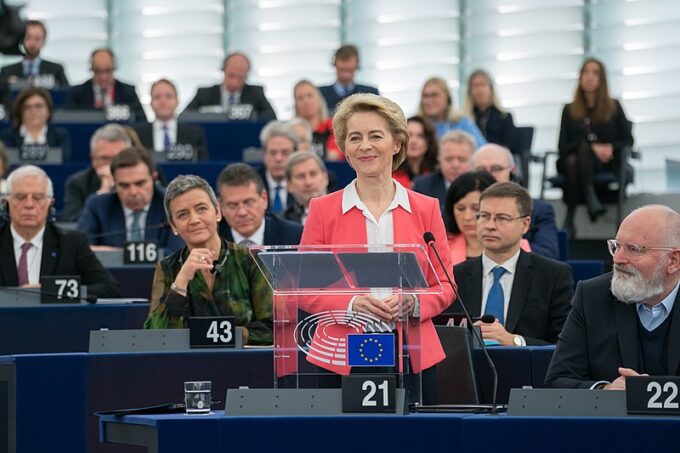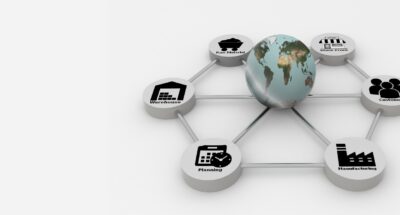
Building systemic resilience in supply chains
Turbulent times can leave businesses scrambling for measures to help them bounce back after disruption. But these actions may in fact increase overall supply chain fragility. ...

by Ralf W. Seifert, Richard Markoff, Alexander Schmidt Published 11 April 2023 in Supply chain • 8 min read
The past few years have been marked by supply chain disruptions. The pandemic, the Suez Canal blockage, worldwide logistics infrastructure bottlenecks, and the war in Ukraine have catapulted supply chain to the headlines and the top of companies’ strategic priorities.
But the most significant disruption of all might still lie ahead in the coming weeks when the European Sustainability Reporting Standards (ESRS), as part of the Corporate Sustainability Reporting Directive (CSRD), are issued. Until now, companies that published information – and in some cases commitments – on their carbon footprints have done so largely voluntarily, motivated in parts by the desire to be responsible corporate citizens, at the demand of their consumers, or to gain a competitive advantage.
This will change with the implementation of ESRS. For the first time, a major global market will legally require companies large and small to, amongst other things, provide a fulsome reporting of their carbon footprints. According to the latest draft, this accounting will consider not just the carbon generated on site but also the carbon in upstream and downstream transportation, processes, and usage – so-called value-chain emissions.
The implications for companies go beyond supply chain management; they present regulatory demands upon data discipline and collection and organizational collaboration that are perhaps unprecedented outside of the realm of finance.
Carbon accounting is the way in which companies capture the greenhouse gasses (GHGs) that they emit. While this might sound relatively straightforward, there is plenty of room for ambiguity about what constitutes credible, accurate carbon accounting.
With the release of the Greenhouse Gas Protocol in 2001, businesses across the world had the first comprehensive guidance on how to estimate their GHG emissions. Now, more than 20 years later, the GHG Protocol has emerged as the gold standard for corporate carbon accounting with more than nine out of ten Fortune 500 companies reporting their emissions in accordance with the Protocol.
At its heart, carbon accounting translates business activities like buying and selling goods and services into GHG emissions. This is done by identifying the appropriate emission factors associated with each economic activity, which can be sourced from, for example, scientific studies and so-called Environmental Product Declarations (EPDs) and tallying them up to arrive at a total footprint. Though it seems straightforward, the actual guidance offered by the GHG Protocol is far more complex and nuanced.
The GHG Protocol provides four different accounting approaches for determining carbon footprints, leaving it to each company to choose amongst them. The approaches differ quite substantially in their degrees of complexity.
For most businesses, a natural starting point will be the spend-based approach, which estimates the GHG emissions associated with a certain business activity on the basis of this activity’s cost. For example, the purchase of a new office table for €150 will be multiplied by an emission factor that contains information on how many GHGs are on average generated per euro spent on purchasing an office table. Estimates generated by this spend-based approach are easy to derive as the financial transactions required for their calculation are readily available to virtually all businesses.
To be ready for the CSRD, each company will need to design their own carbon accounting strategy
At the same time, they come with two major shortcomings. Firstly, the emission factors are based on very broad industry averages and thus will not be very accurate. Secondly, the only lever available for a business to reduce their emissions based on a spend-based calculation is to spend less on a given item or to switch to a comparable item that has a lower cost emission factor.
This is where the second method of carbon accounting offers a solution: the average data method calculates the GHG emissions of a company’s activities by multiplying the quantities of the purchased goods or services by activity-specific emission factors. Continuing our example, we go beyond the €150 monetary value of the table and take into account the material that this table is made of. If the table was made mostly of metal with a few plastic parts, this would result in a very different associated footprint than a wooden table. The company may then look for less carbon-intensive materials for future office table purchases.
As for many businesses it will not be realistic to start their carbon accounting journey with material-level data on all of their purchases, the GHG Protocol offers a hybrid method, combining average data and spend-based approach with the ambition to cover as many of their business activities by the former method as it results in higher accuracy.
It is, however, still possible to further improve the granularity of the GHG calculations. This is achieved by gathering supplier-specific data that allow a business to calculate supplier-specific emission factors. Knowing the emissions of the supplier of the office table or the emissions associated with that specific office table purchase – for example via an EPD conducted by that supplier – such emission factors offer the highest degree of accuracy currently captured by the GHG Protocol.
While the choice of the most appropriate and accurate calculation method will be crucial for calculating a business’s GHG inventory, it should in any case be ensured that the inventory is complete. Such a complete account of GHG emissions translates all business activities into a CO2 equivalent. To break this task down into more actionable pieces, the GHG Protocol defines three scopes of emissions. Scope 1 covers the direct emissions that a company generates while performing its business activities. Scope 2 covers emissions from purchased and consumed energy. Lastly, Scope 3 emissions are all the other indirect emissions that occur in the value chain of a company and are not already included within Scope 2. These emissions are a consequence of the company’s business activities but occur from sources the company does not own nor control. They account for more than 90% of an average company’s emissions.
From this brief – and simplified – overview, it quickly becomes apparent that carbon accounting is not an exact science. The GHG Protocol is widely perceived as the gold standard, but it leaves a range of options for how businesses may calculate their footprints. There is an underlying trade-off at play between simplicity of compiling a complete GHG inventory and the accuracy of the resulting inventory itself.
The introduction of ESRS will progressively require companies to provide their carbon footprints, eventually including virtually all EU companies. This will provide much-needed guidance to businesses with operations in the EU who are currently faced with a plethora of frameworks and standards that exist in parallel to the GHG protocol. It will, however, also create a significant reporting burden that companies must anticipate and prepare for.
Crucially, the reporting standards in their current draft will require companies to report footprints prior to GHG removals, carbon credits or avoided emissions. This will hopefully bring credibility, integrity, and benchmarking to carbon footprint claims that have been beset by scandals, dubious accounting methods and accusations of greenwashing. The regulation requires third-party assurances over disclosures and will be subject to audits, reinforcing the analogy to financial reporting.

Though the details are still under review, it is expected that the reporting requirements will include Scopes 1, 2, and 3. This implies that companies will be obliged to collect extensive data from suppliers and customers, perhaps all the way to the consumer. Capturing, compiling, and reporting this data will be more than a regulatory challenge, it will also be a capability that value chain partners of companies, suppliers, and customers alike will require and demand. Carbon accounting data will quickly become business critical.
To be ready for the CSRD, each company will need to design their own carbon accounting strategy: the accounting method(s) it will use, what data it will need to generate actionable insights, how it will capture and collect the data, and lastly how and with whom it will share the data.
With the stakes so high, data quality is paramount. Using industry averages is a blunt instrument that will likely be insufficient for most value chain partners as it lacks granularity for targeted reduction actions that all actors will be seeking.
Already, consulting companies are gearing up to offer compliance guidance, and there are firms offering intelligent software and expert assistance in carbon accounting across the entire value chain, along with several SaaS-based and open-source platforms to ease in data sharing.
When the detailed standards are released in June, many questions will be answered about what will (or will not) be included in the reporting requirements. Scope 3 calculations in particular, while covering the bulk of a business’s emissions, leaves room for interpretation and might spark renewed debates about the long-acknowledged issue of double accounting.
Many companies, under the umbrella of voluntary sustainability goals, have limited their Scope 3 efforts to challenging vendors to improve their footprints, with little or no data to demonstrate results. These relationships will likely evolve quickly as carbon reporting will be an obligatory element to a service or product offering, changing the nature of business relationships. One could expect new and more intense pressures brought to bear, and may alter strategic supply chain sourcing decisions, product design, and of course unit costs.
The impacts will spill out over the borders of the EU in important ways as well. Importing companies in the most carbon-intensive industries like cement, fertilizer, and steel will be required to provide a full accounting of their embedded carbon in 2023, and in 2026 be subject to carbon trading and pricing, just like their EU competitors under the European Trading System.
The European Green Deal impacts much more than carbon accounting, addressing issues like double materiality, climate risk-mitigation efforts, marine pollution, biodiversity, and the circular economy. Preparing companies for this immense, multi-disciplinary transition will be a unique challenge and critical to success in the years to come.

Professor of Operations Management at IMD
Ralf W Seifert is Professor of Operations Management at IMD and co-author of The Digital Supply Chain Challenge: Breaking Through. He directs IMD’s Leading the Future Supply Chain (LFSC) program, which addresses both traditional supply chain strategy and implementation issues as well as digitalization trends and the impact of new technologies.

Supply chain researcher, consultant, coach and lecturer
Richard Markoff is a supply chain researcher, consultant, coach, and lecturer. He has worked in supply chain for L’Oréal for 22 years, in Canada, the US and France, spanning the entire value chain from manufacturing to customer collaboration. He is also Co-founder and Operating Partner of the venture capital firm Innovobot.

Head of Science and Climate Research at Normative
Alexander Schmidt is Head of Science and Climate Research at Normative and a university lecturer. He previously worked as a consultant and entrepreneur in the fields of data science and artificial intelligence. He obtained his doctorate in economics after completing his studies in international business and East Asian studies in Germany, China, and Japan.

25 July 2024 • by Amanda Williams, Gail Whiteman, Knut Haanaes in Supply chain
Turbulent times can leave businesses scrambling for measures to help them bounce back after disruption. But these actions may in fact increase overall supply chain fragility. ...

4 July 2024 • by Ralf W. Seifert, Philip Sieber-Gasser in Supply chain
The sheer complexity of trade regulation and the risk of non-compliance mean companies are missing out on billions in tariff savings from Free Trade Arrangements (FTA) in their global supply chains. New...

24 June 2024 • by Carlos Cordon in Supply chain
In an era of unpredictability, businesses must take many more strategic decisions about supply chain management, say IMD’s Carlos Cordon and supply chain adviser Tariq Farooq ...

13 June 2024 • by Suzanne de Treville in Supply chain
Many executives recognize the value of local manufacturing but struggle to shake off the view that low-cost production is better for the bottom line. Exploring their options through simulations and competitive games...
Explore first person business intelligence from top minds curated for a global executive audience